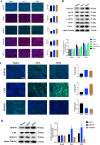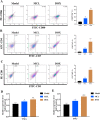Mecheliolide elicits ROS-mediated ERS driven immunogenic cell death in hepatocellular carcinoma
- PMID: 35671636
- PMCID: PMC9168183
- DOI: 10.1016/j.redox.2022.102351
Mecheliolide elicits ROS-mediated ERS driven immunogenic cell death in hepatocellular carcinoma
Abstract
The nonnegligible reason for the poor prognosis of hepatocellular carcinoma (HCC) is resistance to conventional chemotherapy. Immunogenic cell death (ICD) is a rare immunostimulatory form of cell death that can reengage the tumor-specific immune system. ICD can improve the clinical outcomes of chemotherapeutics by promoting a long-term cancer immunity. The discovery of potential ICD inducers is emerging as a promising direction. In the present study, micheliolide (MCL), a natural guaianolide sesquiterpene lactone, was screened out by the virtual screening strategies, identified as an inhibitor of thioredoxin reductase (TrxR) and was evaluated to have high potential to induce ICD. Here, we showed that MCL induced ICD-associated DAMPs (damage-associated molecular patterns, such as CRT exposure, ATP secretion and HMGB1 release). MCL significantly triggered the regression of established tumors in an immunocompetent mouse vaccine model, and induced ICD (DCs maturation, the stimulation of CD4+, and CD8+ T-cells responses) in vivo. Mechanistically, we found that the magnitude of ICD-associated effects induced upon exposure of HCC cells to MCL was dependent on the generation of reactive oxygen species (ROS)-mediated endoplasmic reticulum stress (ERS). In addition, the suppression of ROS normalized MCL-induced ERS, in contrast, the downregulation of TrxR synergized with the ERS driven by MCL. We also systematically detected the H2O2 generation using Hyper7 sensors in HCC cells exposed to MCL. Notably, MCL inhibited the development of HCC organoids. Collectively, our results reveal a potential association between the TrxR inhibitors and ICD, presenting valuable insights into the MCL-activated ICD in HCC cells.
Copyright © 2022 The Authors. Published by Elsevier B.V. All rights reserved.
Conflict of interest statement
The authors declare that they have no known competing financial interests or personal relationships that could have appeared to influence the work reported in this paper.
Figures



















Similar articles
-
Arsenic Trioxide Enhances the Efficacy of PD-1 Inhibitors in Hepatocellular Carcinoma by Inducing Immunogenic Cell Death via the ROS/ERS Pathway.Immun Inflamm Dis. 2025 Jun;13(6):e70214. doi: 10.1002/iid3.70214. Immun Inflamm Dis. 2025. PMID: 40504080 Free PMC article.
-
GPX2 inhibition enhances antitumor efficacy of lenvatinib via promoting immunogenic cell death in hepatocellular carcinoma.J Transl Med. 2025 Apr 18;23(1):456. doi: 10.1186/s12967-025-06468-5. J Transl Med. 2025. PMID: 40251668 Free PMC article.
-
The copper (II) complex of salicylate phenanthroline induces immunogenic cell death of colorectal cancer cells through inducing endoplasmic reticulum stress.Int Immunopharmacol. 2024 May 10;132:111980. doi: 10.1016/j.intimp.2024.111980. Epub 2024 Mar 30. Int Immunopharmacol. 2024. PMID: 38555819
-
Immunogenic cell death inducers for cancer therapy: An emerging focus on natural products.Phytomedicine. 2024 Sep;132:155828. doi: 10.1016/j.phymed.2024.155828. Epub 2024 Jun 13. Phytomedicine. 2024. PMID: 38905847 Review.
-
Targeting immunogenic cell death in cancer.Mol Oncol. 2020 Dec;14(12):2994-3006. doi: 10.1002/1878-0261.12851. Epub 2020 Dec 1. Mol Oncol. 2020. PMID: 33179413 Free PMC article. Review.
Cited by
-
Multi-omics features of immunogenic cell death in gastric cancer identified by combining single-cell sequencing analysis and machine learning.Sci Rep. 2024 Sep 18;14(1):21751. doi: 10.1038/s41598-024-73071-x. Sci Rep. 2024. PMID: 39294296 Free PMC article.
-
Low OGDHL expression affects the prognosis and immune infiltration of kidney renal clear cell carcinoma.Transl Cancer Res. 2023 Nov 30;12(11):3045-3060. doi: 10.21037/tcr-23-961. Epub 2023 Nov 17. Transl Cancer Res. 2023. PMID: 38130311 Free PMC article.
-
Pharmacological Inhibition of TXNRD1 by a Small Molecule Flavonoid Butein Overcomes Cisplatin Resistance in Lung Cancer Cells.Biol Trace Elem Res. 2025 Apr;203(4):1949-1960. doi: 10.1007/s12011-024-04331-0. Epub 2024 Aug 14. Biol Trace Elem Res. 2025. PMID: 39141196
-
Applications and enhancement strategies of ROS-based non-invasive therapies in cancer treatment.Redox Biol. 2025 Mar;80:103515. doi: 10.1016/j.redox.2025.103515. Epub 2025 Jan 28. Redox Biol. 2025. PMID: 39904189 Free PMC article. Review.
-
Study on the Mechanism of QRICH1 Mediating PRMT1 to Regulate the Arginine Methylation Modification of cGAS to Promote Arsenics-Induced Pyroptosis in Hepatocellular Carcinoma Cells.J Hepatocell Carcinoma. 2025 Mar 19;12:597-614. doi: 10.2147/JHC.S505266. eCollection 2025. J Hepatocell Carcinoma. 2025. PMID: 40124968 Free PMC article.
References
-
- Caiado F., Maia-Silva D., Jardim C., Schmolka N., Carvalho T., Reforco C., Faria R., Kolundzija B., Simões A.E., Baubec T., Vakoc C.R., da Silva M.G., Manz M.G., Schumacher T.N., Norell H., Silva-Santos B. Lineage tracing of acute myeloid leukemia reveals the impact of hypomethylating agents on chemoresistance selection. Nat. Commun. 2019;10:4986. - PMC - PubMed
Publication types
MeSH terms
Substances
LinkOut - more resources
Full Text Sources
Medical
Molecular Biology Databases
Research Materials

